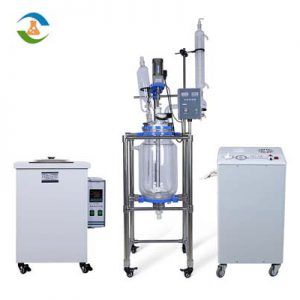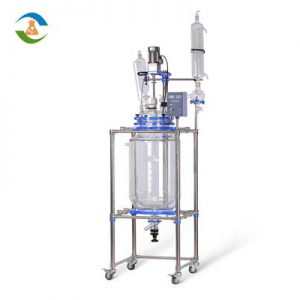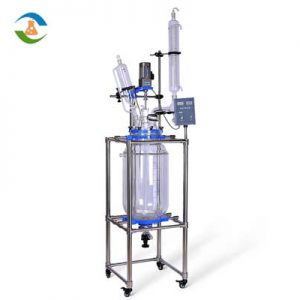The F-20L borosilicate glass reaction kettle is heated by water, oil bath or electric heating mantle, and directly heats the kettle body to keep the reaction temperature of the material constant and provide stirring. Various biochemical synthesis reactions can be carried out under constant temperature conditions, and reflux, distillation or extraction reactions can also be performed at different temperatures. The borosilicate glass reaction kettle, spherical bottle reaction vessel can make the same stirring form produce more sufficient stirring effect. Borosilicate glass reactors are widely used in the chemical industry, food industry, new materials or biopharmaceutical synthesis experiments, production processes and scientific research. The products can be combined with circulating water vacuum pumps, low-temperature cooling liquid circulating pumps, etc. to form a system device.
Borosilicate glass reactor supporting equipment:
1. DLSB-10/20 ℃ low temperature coolant circulation pump.
DLSB-10/20°C low-temperature coolant circulation pump uses a fully enclosed compressor unit for refrigeration and a microcomputer intelligent control system, which can provide low-temperature liquid and low-temperature water bath to satisfy cooling water and low-temperature liquid for cooling or constant temperature for other instruments. It is also possible to carry out low temperature and constant temperature experiments directly in the tank with various volumes.
2. SHZ-C circulating water vacuum pump.
SHZ-C circulating water multi-purpose vacuum pump adopts double taps, which can be used alone or in parallel. It is equipped with two vacuum gauges, which are mainly used to provide vacuum conditions for chemical laboratories, and can provide circulating cooling water to reaction devices. Corrosion-resistant, pollution-free, low-noise, easy to move, and can also be installed with a vacuum regulating valve according to user needs to reduce the experimental space.

Borosilicate glass reactor advantages:
The reaction solvent placed in the borosilicate glass reaction vessel can be used to stir the reaction. The interlayer realizes constant temperature heating or cooling reaction through the circulation of cold and heat sources. The distillation and reflux of the reaction solvent can be controlled. Borosilicate glass reactors are ideal testing and production equipment for the preparation of modern synthetic chemicals, biopharmaceuticals and new materials.
- Frequency conversion controller: keep the operation stable.
- PTFE gasket between the kettle body and the lid: protect the glass with a higher vacuum degree.
- Large size lid: easy to clean.
- PTFE/mechanical double seal: it is wear-resistant, corrosion-resistant, and has good sealing performance, ensuring high-precision sealing under working conditions.
- Solid feeding port: high vacuum, easy to operate, protective glass.
- Liquid feeding port: the liquid does not hang on the wall, which is convenient for cleaning the inside of the kettle.
- Temperature measuring port in the kettle: the protective glass port will not be damaged during high-speed stirring.
- Constant pressure dropping funnel: easy to operate, and the glass parts are not easy to be damaged.
- Condensation reflux or recovery: easy to operate and protect the glass.
- Uniquely designed discharge bottom valve: to eliminate problems such as liquid leakage and poor discharge.
- Kettle body interlayer insulation buffer tube: protect the precious glass kettle body and your materials.

Application of borosilicate glass reactor:
1. Stirring reaction
The borosilicate glass reactor has the function of stirring, and the gas, liquid and even suspended particles in the solution can be mixed evenly through the circulation of the stirrer. By putting in different liquids or substances and stirring them, the liquids are prevented from evaporating and refluxing, so as to make the mixing more thorough.
2. Purification reaction
As an important chemical method, purification not only plays an important role in chemical research, but also plays a very important role in chemical production. Borosilicate glass reactors go through a series of steps to extract pure liquids and desired materials.
3. High temperature reaction
“High temperature” means that the temperature must be very high when this reaction occurs, and the borosilicate glass reactor makes many experiments can be carried out normally.

Parameter
Single layer glass reactor
| Model | Stirring Power(W) | Stirring Speed(rmp) | Heating Power(kW) | Capacity(L) | Temperature Using Range(℃) | Motor Torque(g/cm) |
| F-1L | 60 | 0~1000 | 0.5 | 1 | RT-250/RT-350 | 2000 |
| F-2L | 60 | 0~1000 | 0.8 | 2 | RT-250/RT-350 | 2400 |
| F-3L | 60 | 0~1000 | 1.2 | 3 | RT-250/RT-350 | 2400 |
| F-5L | 60 | 0~1000 | 1.5 | 5 | RT-250/RT-350 | 4800 |
| F-10L | 120 | 60~600 | 3 | 10 | RT-250/RT-350 | 1000 |
| F-20L | 120 | 60~600 | 4.5 | 20 | RT-250/RT-350 | 1200 |
| F-30L | 120 | 60~600 | 6 | 30 | RT-250/RT-350 | 1200 |
| F-50L | 120 | 60~600 | 7 | 50 | RT-250/RT-350 | 1500 |
| F-100L | 180 | 60~600 | 9 | 100 | RT-250/RT-350 | 3000 |
Jacketed glass reactor
| Model | Power(W ) | Stirring Speed(rmp) | Diameter | Capacity(L) | Power Supply | Motor Torque(g/cm) |
| S-1L | 60 | 0~600(Max.1300) | 12 | 1 | 220V 50/60 Hz | 2000 |
| S-2L | 60 | 0~600(Max.1300) | 12 | 2 | 220V 50/60 Hz | 2400 |
| S-3L | 60 | 0~600(Max.1300) | 12 | 3 | 220V 50/60 Hz | 2400 |
| S-5L | 60 | 0~600(Max.1300) | 12 | 5 | 220V 50/60 Hz | 4800 |
| S-10L | 120 | 0~600(Max.1300) | 12 | 10 | 220V 50/60 Hz | 1000 |
| S-20L | 120 | 0~600(Max.1300) | 12 | 20 | 220V 50/60 Hz | 1200 |
| S-30L | 120 | 0~600(Max.1300) | 12 | 30 | 220V 50/60 Hz | 1200 |
| S-50L | 120 | 0~600(Max.1300) | 12 | 50 | 220V 50/60 Hz | 1500 |
| S-100L | 250 | 0~600(Max.1300) | 15 | 100 | 220V 50/60 Hz | 3000 |
FAQ:
1. What materials are used for borosilicate glass reactors?
The material used in the borosilicate glass reactor (G3.3 borosilicate glass) has excellent material and chemical properties. In the stirring process of frequency conversion speed regulation, the operation will be relatively stable, and no sparks will be generated even if the torque is large.
2. How to clean the sealing ring of borosilicate glass reactor?
Remove the borosilicate glass reactor sealing ring, wipe off the dirt on the shaft with a soft cloth, apply a little vacuum grease, and reinstall it to keep the shaft and sealing ring lubricated.
3. How to improve the use effect of borosilicate glass reactor?
Mainly lies in the choice of temperature control medium and heat preservation medium. According to the required reaction temperature, temperature control media with different properties are selected as the heat transmission medium for the reaction. Choose ice ethanol bath for low temperature; choose water bath for normal temperature; choose oil bath for high temperature. In the process of using high temperature and low temperature, it is necessary to use insulation materials to protect the body of the borosilicate glass reactor.





